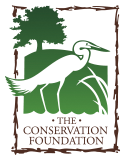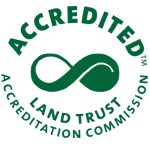Earth-Friendly Landscaping
Whether you are starting from a grass lawn or have existing natural areas on your property, the Conservation@Home program can help you make your yard more attractive to wildlife and retain precious rainwater. Steps you can take include planting native plants that support butterflies and other pollinators, installing a rain garden or rain barrel or composter, and removing plants introduced from Europe and Asia. Not only will you be contributing to a healthier environment, you can spend valuable outdoor time as a family, and you’ll get to enjoy nature’s ever-changing cast of characters right outside your window.
Beautifying your yard while conserving water and creating habitat for wildlife can be easy and rewarding! Adding native plants can help you save money, mow less, see more birds and butterflies and enjoy a functioning yard with fewer problems and less effort…
Why Native plants
At the core of environmentally friendly landscapes is the use of native plants, the absence of fertilizers or pesticides, and smart water use. Native plants are those species that were thriving locally when the first settlers arrived. These plants have evolved over thousands of years to survive the soils and seasonal conditions of cold, rain and drought of our northern Illinois climate.
As the country was settled, more and more land was converted from native landscape to farm fields, cities, roads and suburban development. Plants that have historically been planted as replacements have been introduced from outside our local region – usually from Europe or the Far East. This has broken the dependent relationships that evolved over thousands of years between native plants and the birds and animals that are dependent on them directly or indirectly for their survival. For example, today less than 0.01% of native prairie is left in Illinois of what was seen by the original settlers in the early to mid-1800s. The decline of many species of birds and fewer butterflies in our gardens are directly linked to these changes.
Loss of open space and wildlife habitat, degradation of what remains, and dirty stormwater runoff are the leading causes of environmental problems in our developed areas. If we can replace some of this lost habitat in our yards and conserve rain water before it runs into our roads, then we can reduce some of the negative impacts of development, have cleaner water in our neighborhoods and enjoy a better quality of life. We will also be restoring the food sources (in the form of native plants) that have been lost to our pollinators as land has been developed over the past 200 years. This single act of adding native plants – including trees and shrubs – to our gardens will significantly help make our gardens not only beautiful but productive and full of life!
Just What is a Native Plant?
Native plants are typically defined as those trees, shrubs, wildflowers and grasses that evolved over thousands of years to our climate and soils. The assemblage of plants that evolved together in a particular place with certain light, soil and water conditions is called an ecosystem. These can be largely treeless (prairie or wetland) or have differing densities of trees (savannah, woodland, forest.) Within any of these categories there can also be other subcategories based on soil moisture. So a prairie (or full sun condition), can be wet or dry. The Chicago Wilderness Atlas of Biodiversity is a great resource to learn more about our pre-development plant communities.
Usually, when ecologists talk about native plants they are considering those plants that evolved in the Great Lakes Basin rather than Colorado, Kentucky, California or any other region of the country. Dependent upon the project requirements, they may specify native species whose genetic history is from within a 250 mile or even 25 mile radius of where the planting is being done.
In choosing natives to plant in your gardens, your best chance of success is first to generally match the soil, water and light conditions of the native plants in your garden according to where the plants grew historically, and second to buy plants whose genetics are from within your region. For example, if your garden gets more than 6 hours of sun a day, the best plants to look at are those that are considered prairie species. If you were to choose Little Bluestem (Schizachyrium scoparium) to add to your garden – a beautiful native grass – try to purchase plants whose genetics are from northern/north central Illinois, southern Wisconsin or northern Indiana. Little Bluestem from the Great Plains would have different evolutionary history and different genetics, and might not grow as well (or too aggressively) in your garden.
If you have more shade on your property, native plants that grow in woodlands are a better match. That said, you can plant at least some woodland natives in full sun conditions as long as good soil moisture is available through the growing season. It is more difficult to plant prairie species in shaded conditions and expect them to thrive.
This may sound way too complicated but there are many reliable ways to purchase local native plants and connect with helpful organizations. Many of them are listed in our Resources section. Below are some native plant guides we love:
- Possibility Place Nursery’s Plant Finder
- Natural Garden Natives.com (includes a list of native plant sales and how to find local garden centers that sell Natural Garden Natives®)
- Natural Communities Native Plants
- Prairie Moon Nursery (although headquartered in Minnesota, many species are available in more local genotypes)
- Prairie Nursery
What About Native Plant Cultivars?
The world of native plant selections (cultivars) can be very confusing to the home gardener. As the popularity of native plants has increased, many growers have started developing more and more selections of native species that meet certain characteristics. Early on this was most seen with native shrubs. For example, Red-Osier Dogwood (Cornus sericea) is a native shrub that grows throughout most of the continental United States. In the wild it is a 3-9’ tall multi-stemmed shrub that grows in silty, sandy or loam soils in full or partial sun. It prefers moist conditions and can withstand temporary flooding. With its red stems, it is eye-catching in the winter.
Plant breeders saw these red stems, as well as its spring flowering, fruit and maroon fall color and set to work to “enhance” one or more of these characteristics for the garden and landscape market. The selections they came up with through breeding include:
- ‘Cardinal’- Bright red stems in winter, better disease resistance, grows to 10′ tall and wide
- ‘Flaviramea’- Stems turn bright yellow in winter instead of red, but susceptible to canker
- ‘Isanti’- A dwarf form that grows 5′ to 6′ tall and 8′ to 10′ wide. Fruits heavily, but can be susceptible to leaf spot
- ‘Kelseyi’- Dwarf form that grows to 3′ tall. Stem color and fall foliage color is less than other selections
- ‘Silver and Gold’- From ‘Flaviramea.’ Stems are yellow, leaves are variegated with an irregular yellow border

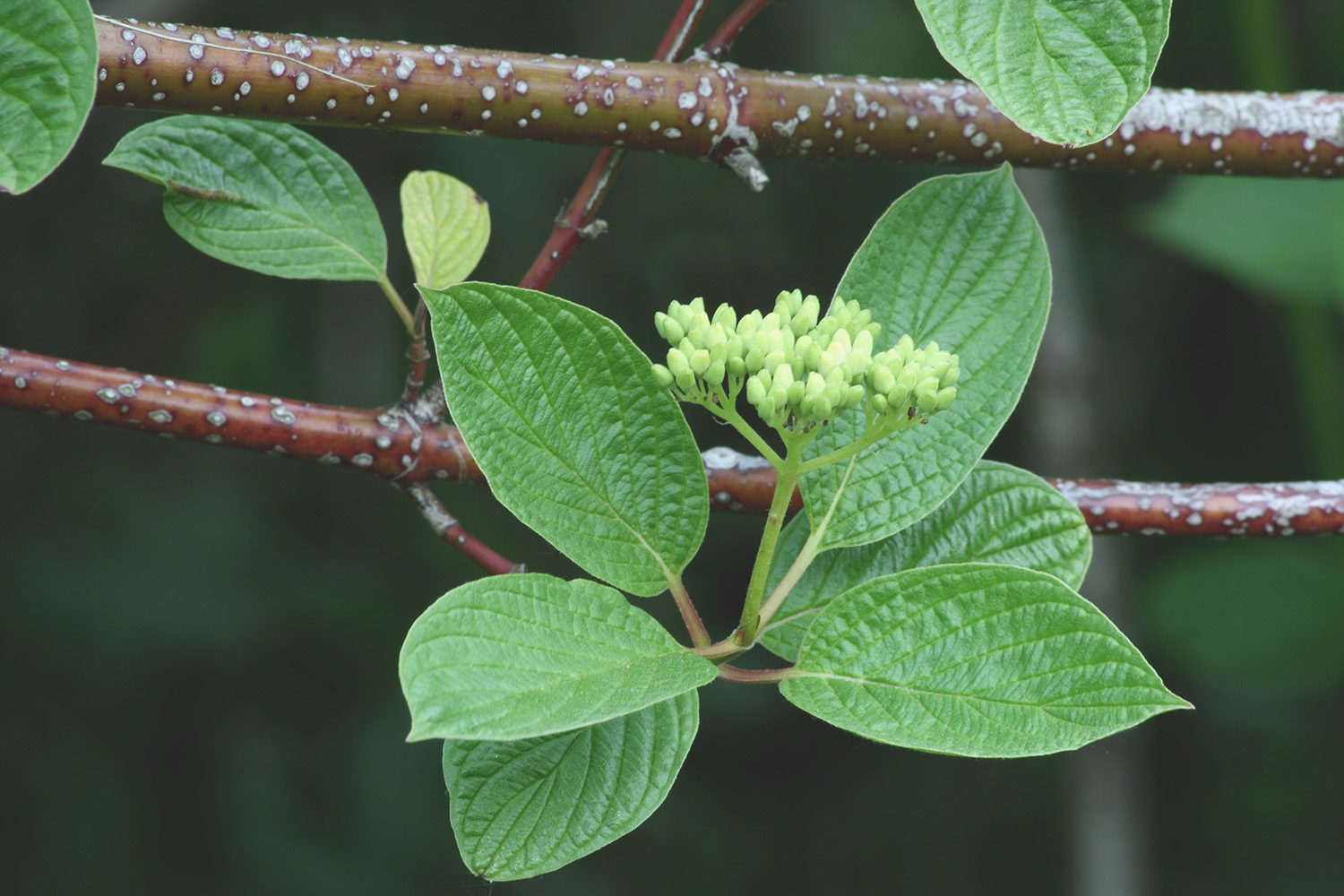
A selection of a species, called a cultivar, is given an additional name which is written in single quotes. So the correct way to write Isanti Dogwood is Cornus sericea ‘Isanti’.
Little Bluestem (Schizachyrium scoparium) is another native plant where many cultivars have been developed and introduced to the market. ‘The Blues’ was developed for its intense blue color but it tended to fall over. ‘Stairway to Heaven’, while not as blue, remains more reliably upright but ‘Standing Ovation’ – which is also more consistently upright – can be more reliably produced. ‘Carousel’, growing to about 3’ tall, was selected to be a lower-growing version of the species. And there continue to be others. Another term that is becoming popular is “nativar” which is simply a cultivar of a native plant.
Understanding cultivars helps explain several things. In order to consistently grow the desired characteristic(s) the plant has been bred for, a cultivar cannot be grown from seed. So every Carousel Little Bluestem or Isanti Dogwood is genetically identical to every other plant with the same name. Buying cultivars for your garden can reduce its genetic diversity and resiliency against disease and changing climate conditions. In addition, sometimes, when breeding for a certain characteristic, the new selection may be less hardy or more susceptible to disease.
Most importantly, however, when a cultivar is developed, other traits of the plant, such as the amount of pollen or nectar produced or the physical characteristics that pollinators use to identify the correct landing spots on the flower, may be negatively impacted. In fact, some don’t consider cultivars of native species to be native plants at all!
Research in this area is just beginning and should be done for each individual selection. What is understood about the food value of the Isanti Dogwood, cannot be assumed to be true for the cultivar ‘Cardinal’. This is the primary reason we recommend planting straight species whenever possible. If this is not possible, your second choice are cultivars on native species over most plants introduced from Europe and Asia.
Helpful Links to Learn More About Native Cultivars
- From Nursery to Nature: Are native cultivars as valuable to pollinators as native species? – Annie S. White
- The Nativar Conundrum: New Research on Natives vs. Native Cultivars with Dr. Doug Tallamy
- Chicago Botanic Garden’s Project Budburst (join to get involved in the research in your own garden)
Solving Problems with Native Plants
One adage that supports success in any garden is “right plant, right place.” This is also true when selecting native plants. The wide selection of native plants in the market today makes it easy to use natives to solve many of the problems you might find in your yard. Questions you might be asking…
“I just don’t know what to do with that spot in the back corner that always seems to be wet… or “floods every spring… or “that always gets water runoff from my neighbor’s yard when it rains…”
If you have a wet spot in your yard, don’t ever feel like you have to bring in dirt to make it dry. There are many native trees, shrubs, wildflowers and grasses that are adapted to these kinds of conditions that are beautiful additions to any garden. Watch our webinar on plants for wet and shady spots.
I want to block the view of the neighbor’s yard? I don’t want to take out my buckthorn because then I’ll see my neighbors!
While we understand your wanting to maintain your privacy, we cannot support your decision to maintain buckthorn. The Chicago Region Trees Initiative has suggestions here that will add health and life as part of a living fence.
Nothing will grow in the shade under my maple!
Well, we confess, it is very hard to find plants that will grow successfully under the shade of a Norway Maple, an introduced species that is considered invasive. Watch our webinar on plants for shady or wet spots.
I have a place next to my (driveway, garage, sidewalk…) that just bakes in the sun and is very dry. Would this be a good place to use a native plant?
Many native species are adapted to dry soils (typically of the sandier kind). Check out these plants for sunny areas in our webinar.
Helpful Tips
Many people who want to include natives are reluctant to add plants that will make a garden look “messy,” but there are numerous examples in our area where native landscaping is a resounding success. There are hundreds of homes we have visited and certified over the years as part of our Conservation@Home program that are helping to add back lost habitat through their native gardens. The butterfly garden planted in front of The Conservation Foundation’s office is an example of Conservation@Home.
Careful selection of the native plants you want to add, done exactly as would be done with other plants you purchase, will help you succeed and we are here to help! With the right selections, you can easily incorporate native plants into existing or new gardens and create beautiful oases of life. Here are some helpful hints to consider.
- As with any plant you add to your garden, choose species that generally match the growing conditions of your location.
- Purchase native plants from a reputable grower that does not dig wild plants. Also make sure that the plant’s genetics are from regional sources.
- Think about the mature height of the plant and, unless you have a larger area, generally choose native perennials and grasses that grow to less than 3-4 feet high. There are places to use taller native species but often their effect is not as successful in a smaller residential garden.
- Plant into the existing soil. Native plants do not need fertilizers or other soil amendments. Soil that is too rich will cause overgrowth of some species and they will look unattractive.
- If you live in a relatively new development that had most of the topsoil removed during development and are trying to dig in heavy clay, mix in some leaf mulch. You don’t need much though; we suggest a 20:80 mulch to soil ratio.
- Turning soil over as part of the mixing process will often expose weed seeds. Be prepared and watch so you can get an early handle on controlling them.
- Hand pull weeds to keep them in check and remove competition for light and water.
- Mulch your new planting area to help keep unwanted weed growth down. It is best to use a leaf mulch rather than wood chips in a perennial garden. If using wood chips, make sure they are aged and shredded.
- It’s fine to cut back most native plants if you think they get too large for the garden. This works most successfully with native plants that bloom later in the summer and fall. Cut them back to 6-8” in late May or early June. They will come back fuller and will flower at a shorter height.
- Since many butterflies and other pollinators overwinter in leaf duff, hollow stems or in the ground it is better to wait on cleaning up the garden until spring when the weather warms. Leaving some flower heads and tall grasses also adds a nice dimension to the winter landscape and provides seeds and protection for birds and other species. The chrysalis of the Clearwing Hummingbird Moth that overwinters in leaf litter is a good example.
- Some, but not all, native plants spread easily by seed if there is a lot of bare ground in your garden. If you do not want them to spread to other parts of the garden, cut off the seed heads or pods and dispose of them before they ripen.
Invasive plants
A plant becomes invasive by being able to grow successfully and out-compete other plant species for water, nutrients and sunlight. Typically this happens because they have been taken out of their natural environment (Europe and Asia in the case of buckthorn) and now have no natural controls. An introduced species may only become invasive over time, and some, such as Hosta, never do.
How does a plant become invasive?
Characteristics that increase the risk of an introduced species becoming invasive include their ability to grow quickly, to be adapted to a broad range of soil and light conditions, and to be prolific seed producers. Another good example of this that is a terrible problem in the southeastern U.S., is Kudzu (Pueraria montana var. lobata). Deliberately introduced from Asia to control erosion, it is now overgrowing virtually everything. Its presence has been reported in a number of counties in southern Illinois and there has been one report from Evanston, IL.
Buckthorn is spread by birds who eat the fruit that has a cathartic effect. The Kudzu, a climbing vine, can grow up to 100 feet in one season.
Common Buckthorn
Back in the mid-1800s when Common Buckthorn (Rhamnus cathartica) was first introduced in the U.S. as a hedge plant, no one had any idea it would become one of the worst invasive species in the Chicago region. Today it comprises 40% of the canopy cover included under the Chicago Region Trees Initiative. “So what?” you might say. Well, the problems caused by this plant invasion are typical of those caused by any other plant species that is included under this category.
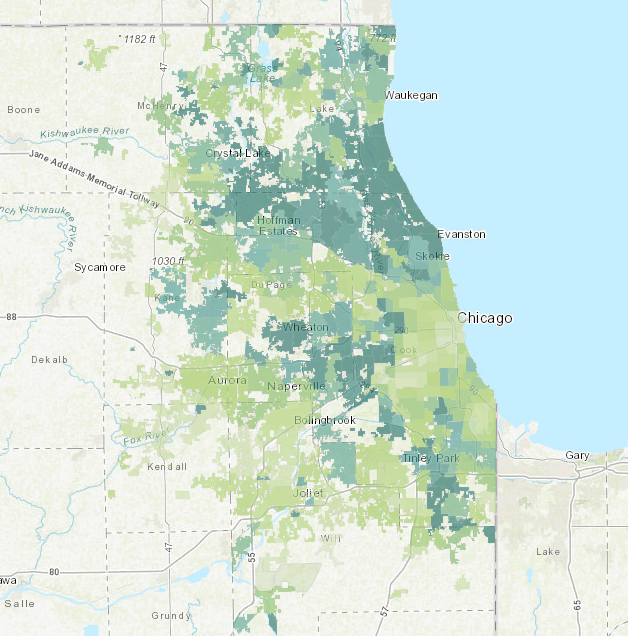
Land area addressed by the Chicago Region Trees Initiative. Image courtesy of CRTI.
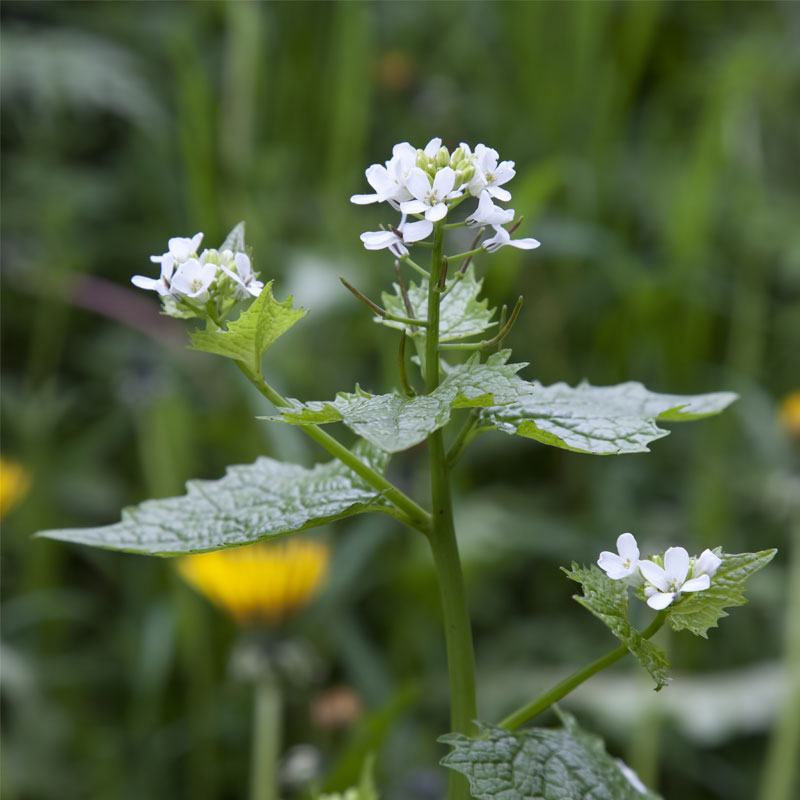
The introduced plant that is currently becoming a serious problem similar to Common Buckthorn is Bradford Pear (Pyrus calleryana ‘Bradford’). Although bred to be a sterile cultivar, Bradford Pear has crossbred with many other P. calleryana cultivars planted nearby and produced viable seed.
Other commonly used introduced garden plants that are now identified as invasive include Burning Bush and Japanese Barberry. Two references that are helpful are the Midwest Invasive Plant Network and the Chicago Botanic Garden’s Invasive Species list. Under MIPN’s publications tab, you can access a free downloadable mobile app and pdf that offers a list of recommended alternative plant selections for home gardens. It is also helpful to read CBG’s Invasive Plant Policy.
Why are invasive plants a negative thing?
First, and most importantly, since our moths, butterflies, native bees, etc. did not evolve with an introduced plant from another continent, that plant is not an equivalent food source for these critters. Since plants are at the bottom of the food chain, the bugs that depend on them are fewer because there is less food, as are the birds that depend on the bugs and so on.
Now, you might see a butterfly sipping nectar (or at least looking for it) on a flowering plant that originated in China – Astilbe for instance – but chances are good that the plant does not provide food for the caterpillar or a home for a chrysalis.
Secondly, as an invasive species outcompetes our native plants in natural areas, the natives there slowly disappear as they are displaced or unable to survive in lower shade and soil moisture conditions. In the case of Common Buckthorn, all the native plants in the ground plane are unable to survive. As they die out, the ground under them becomes a food desert. As added insult, Common Buckthorn doesn’t provide a nutritious meal either!
This is a simplified explanation of what happens, but this is what generally follows the invasion of any introduced species into our valuable natural areas. They may not currently be as problematic as Common Buckthorn but you don’t always know when a plant is going to become more problematic. This is why ecologists worry anytime they see any plant that doesn’t belong in our woodlands, prairies and wetlands.
Healthy Soil, Healthy Lawns
Make simple lawn care choices to manage your yard that are more healthy for you, your community and the environment.
The use of native plants is key to any environmentally friendly landscape. The deep roots of native plants reach far down into the ground, firmly rooting soil and reducing erosion, and also absorbing rain where it falls to carry it back down to our groundwater supply, filtering it as it goes.
Consider replacing a patch of high-maintenance lawn with lower-maintenance native perennial plants. Plants native to northern Illinois thrive in our weather conditions, requiring less water once established, and generally do not need fertilizers or pesticides. Native plants also provide habitat and food for birds and butterflies.
Non-native species compete with and often choke out more beneficial and well adapted native species. Unleash any workplace stress on the nearest garlic mustard, European buckthorn or bush honeysuckle!
Why spend money and drinkable water on irrigation efforts when what you need literally falls from the sky? Rain barrels and larger scale rainwater harvesting can capture the rainwater that falls on your property so you can put it to use and keep it from running off, collecting pollutants as it goes and carrying them into our rivers and streams.
The runoff of chemicals from fertilizers, herbicides and pesticides is a major pollutant in our rivers and streams. Work to reduce or eliminate the use of fertilizers, weed treatments, salt and other chemicals, which are harmful to birds, butterflies and other two and four-legged visitors, and also to fish and aquatic life when they reach our waterways.
When using chemical treatments in your yard, follow the instructions carefully, apply only the recommended amount and use these products as sparingly as possible. Check the weather forecast to avoid having to repeat the application. Better yet, hand pick weeds when possible or consider less toxic alternatives. Long-handled weed pullers grab dandelions easily, especially when the soil is moist. Allow beneficial insects like lady bugs, praying mantises, and green lacewings into your garden to feed on pests. For better success, replace diseased or problem plants with native varieties.
When mowing the lawn, use the mulching feature rather than bagging the clippings. Returning grass clippings to the yard keeps your lawn healthy and saves space in the landfill. In fact, the clippings contain valuable nutrients that can generate up to 25% of your lawn’s total fertilizer needs. Grass clippings do not contribute to thatch since they are 75 – 85% water and decompose readily. Grass clippings also make great mulch in your vegetable garden.
Build healthy soil by recycling organic material for plant growth. Leaves, grass clippings, weeds, prunings, dead flowers and ash from burnt wood can be composted…not only to reduce yard waste, but to nourish your landscaping. Composted materials provide important nutrients for soil and plants. For more information on composting visit the University Of Illinois Extension Service “Composting in the Home Garden” website.
Coal tar, a byproduct of coal processing, contains high levels of a toxic chemical called polycyclic aromatic hydrobarbons (PAHs). When an asphalt driveway is sealed with these products, the PAHs wear off and the asphalt breaks down into particles that wash off into the streams and rivers when it rains. Use a safer petroleum-asphalt based sealcoat to protect yourself and the environment.
Yard waste must be properly prepared and placed for collection. Leaf collection services vary by community; check with your community for leaf collection options. Dumping yard waste into storm drains or waterways adds excess nutrients to the water, can clog the drains and contribute to roadway flooding; and it is illegal.
Animal waste contributes to surface and groundwater bacteria, so it is important to remove pet waste from your yard and pick up after him at the park, or wherever he goes when you’re out walking. Place it in the trash, bagged, or flush smaller quantities down the toilet.
We’ve all seen leaves piled in the road gutters, and clogging storm drains when it rains and washes the leaves away. The leaves are washed into lakes, rivers and streams. Eventually the leaves reach area waterways, and as they break down in the water, they release high levels of phosphorus that cause algae to grow. Algae is harmful to health of ponds and rivers. Place your leaves in your compost pile or bag them for pick-up. Snow and ice are also frequently to blame for storm sewer backups, so grab the shovel and keep storm drain openings clear.
1″ per week is enough rain/water to keep most lawns healthy. Watering too much or too little is the cause of many common plant problems. You can have healthier plants and save money by giving your lawn/garden only what is needed.
About that
Turf grass
Americans have a fascination with turf grass, large swaths of perfectly manicured, uninterrupted green lawn. We all appreciate a place to set up yard games, toss a football with the kids, play fetch with Fido and spread out a blanket for a picnic or nap in the sunshine, but by trading in some of that lawn for native plants and grasses, you can open up a whole new world for the other species that share your neighborhood and simplify your own life as well!
Did You Know ?
- Turfgrass is the #1 surface covering the US – Over 40 million acres of grass!
- An average lawn uses 21,600 gallons of drinking quality water per season.
- We use 3 million TONS of fertilizer on lawns, much of which is not needed and ends up washing off into our rivers, polluting them and leading to poor water quality.
- Americans spend $6.4 BILLION on lawn care products each year – and $50 billion more on lawn care companies to mow and maintain our yards.
- Grass does not absorb water well, and can be detrimental to trees when growing under them.
- Turf grass has 0 value for wildlife… the turf grass portion of your lawn is an ecological desert for birds, butterflies, insects, frogs, and most other creatures.
- Pollution emitted from a lawnmower (hour per hour) is greater than that of an automobile.
We’re not trying to say you should get rid of your entire lawn, but having LESS lawn and more native flowering plants will reduce mowing time and improve habitat for birds and butterflies as well as look beautiful too.
In areas where you do want to keep grass, we advocate using far less fertilizer than typically recommended, and definitely switching to a natural rather than synthetic fertilizer.
There are loads of articles online about turf grass and better ways to feed and maintain it in ways that are less harmful to the environment, or feel free to contact us for more help! Reach out to Jim Kleinwachter by email or call 630-428-4500, Ext. 115.
Need professional help?
We think these companies do a nice job with natural lawn maintenance:
Bio-Lawn
Naperville, IL
630-204-5296
www.biolawn.net
DigRightIn Landscaping
9100 W. Plainfield Rd.
Brookfield, IL 60513
708-485-7751
www.digrightin.com
Chem-Wise
Aurora, IL: 630-236-1600
Batavia, IL: 630-879-1520
www.chem-wise.com
Pure Prairie Organics
Naperville, IL 60540
(630) 204-5296
www.pureprairieorganics.com
_____________________________________
Ready to trade out some turf grass for native plants? Check out these local plant sources:
Retail
The Growing Place
2000 Montgomery Road
Aurora, IL 60504
630-820-8088
25w471 Plank Road
Naperville, IL 60563
630-355-4000
www.thegrowingplace.com
Natural Communities Native Plants
Batavia, IL
(331) 248-1016
www.naturalcommunities.net
Possibility Place
7548 W. Monee-Manhattan Road
Monee, IL 60449
708-534-3988
By Appt. Only
www.possibilityplace.com
Wannemakers
1940 Ogden Ave.
Downers Grove, IL
630-852-0700
www.wannemakers.com
Wasco Nursery and Garden Center
41W781 RT 64
St Charles, IL 60175
(630) 584-4424
www.wasconursery.com
Wholesale
Applied Ecological Services, Inc.
17921 Smith Road
Brodhead, WI 53520
608-897-8641
www.appliedeco.com
Cardno Native Plant Nursery
6605 Steger Road, Unit A
Monee, IL 60448
708-534-3450
www.cardnonativeplantnursery.com
Midwest Groundcovers
Route 25 (4.5 miles north of Rt. 64)
St. Charles, IL 60174
847-742-1790
www.midwestgroundcovers.com
The Pizzo Group
136 Railroad St
Leland, IL 60531
815-495-2300
www.pizzogroup.com
Possibility Place
7548 W. Monee-Manhattan Road
Monee, IL 60449
708-534-3988
www.possibilityplace.com
